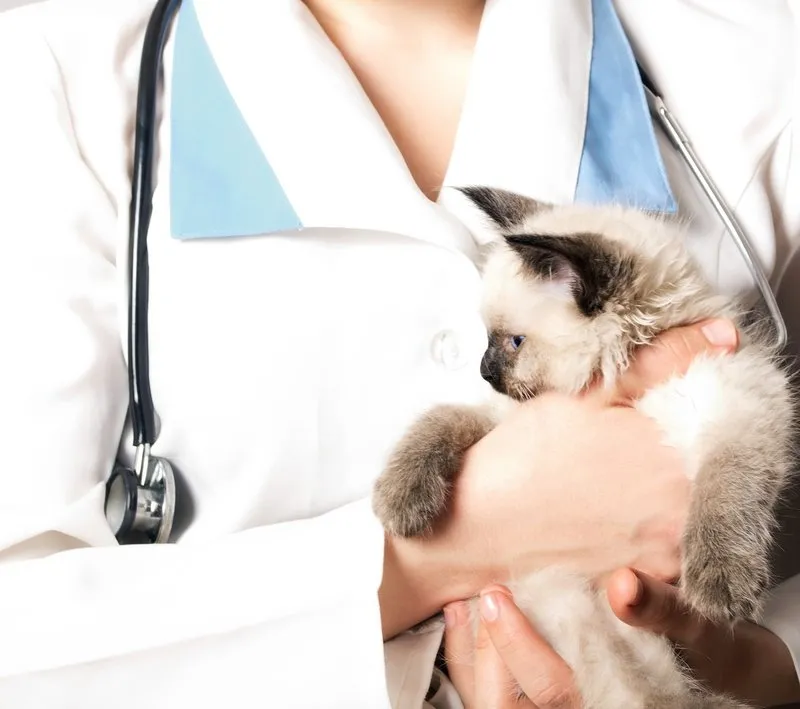We celebrate a variety of holidays and important awareness events in April, such as National Hug Your Dog Day, Cat Lady Day, Little Pampered Dog Day, and Tuxie Appreciation Day. There are also a few events on the calendar that don’t seem very appealing. For instance, it’s Heartworm Awareness Month. April also brings Hairball Awareness Day. Although hairballs may not be the most pleasant subject, it is important for all cat owners to be aware of them. A local Roanoke, VA veterinarian offers some insight on this ‘hairy’ topic below.
Understanding Hairballs
Hairballs are officially known as trichobezoars. These are a little ugly drawback of one of Fluffy’s best features: her cleanliness. Your cute little diva may spend a significant portion of her day grooming herself and keeping her fur shiny and clean. Unfortunately, she will ingest some of her own fur during her beauty routine.
Did you know that cats have papillae, which are actually microscopic hairs, on their tongues? That’s the reason your furry companion’s tongue has a sandpaper-like texture, which you may notice when she licks you. Those tiny follicles are positioned in a way that allows anything she ingests to easily glide down her throat. This would of course aid in Fluffy’s digestion of birds and mice, but it also facilitates the swallowing of her own fur.
You likely have a good idea of what comes next. Fluffy may retch and gag before leaving a rather unpleasant mess on the floor. Or your bed. Or your shoes. Let’s just say it’s not her cutest trick.
How Often Do Cats Normally Get Hairballs?
In an ideal world, your beloved feline buddy would only experience hairballs on rare occasions, if at all. However, for most cats, it occurs more often than you or your feline companion would prefer.
Time frames can vary from cat to cat, but many kitties get them about once every week or so. If your cat is experiencing them more often than that, reach out to your veterinarian for assistance. It’s possible that this could indicate some medical issues. Please reach out to your Roanoke, VA pet clinic for more information.
Can Giving Fluffy Canned Food Reduce Hairballs?
While canned food is not a cure, it won’t hurt. Cats tend to digest canned food more rapidly than they do dry food. Everything will move through Fluffy’s system a bit faster, which may help.
There are several factors to consider when deciding whether to feed your feline friend dry food, wet food, or a combination of both. For more information about your feline friend’s nutritional needs, contact your vet.
How Can I Keep My Pet From Getting Hairballs?
This is where you may assist your animal friend in a few ways.
Brushing Fluffy is an excellent approach. You’ll easily remove the loose fur with a brush to prevent your cat from ingesting it. Less fur on your cat will eventually lead to less fur in your cat.
There are other reasons to brush your pet, though. For one thing, it helps your pet’s circulation. Grooming also helps to foster a sense of connection. A lot of our feline rulers absolutely love being spoiled.
How Do I Brush My Cat?
This isn’t rocket science, but there are some do’s and don’ts to keep in mind.
Wait till your furry friend is relaxed and a bit sleepy. (Given how much time cats spend sleeping, this shouldn’t take long.) Begin by gently stroking her fur, making sure to follow the natural flow of her coat. Next, begin incorporating the brush.
Take care not to use too much force! If you’re having trouble removing the knots with a detangling brush, you might consider trimming them. Please make sure to use scissors with round ends. Another option is to use a plastic letter opener, the type that looks like a credit card with a notch cut out. Get that motor going by offering plenty of attention and compliments, along with a delicious treat.
When Fluffy decides that she’s had enough, just let her go. Trying to coerce her into submission is unwise: that’s a good way to get scratched.! Plus, Fluffy might not be as enthusiastic about letting you brush her next time!
In addition, your veterinarian may recommend applying pet jelly to Fluffy’s paws. When she cleans herself, she’ll lick it off, giving her digestive system a little extra lubrication.
Your pet will probably be more enthused about this one. Occasionally, you can treat your furry friend to a can of tuna or sardines. The oil in these can provide some benefits. Consult your veterinarian about this as tuna may not be suitable for your pet if she has certain medical issues, such as thyroid problems.
Additionally, there are products available to help prevent hairballs. Ask your vet for advice on these, as not all products are suitable for every cat.
It’s also important to ensure that Fluffy stays hydrated. Consider getting her a small kitten fountain. Many cats love running water!
We would also suggest that you keep your feline pal indoors. Indoor cats are not as affected by seasonal changes in the weather that trigger shedding, so they tend to shed less. Fluffy also won’t be rolling around in dirt or dust. Of course, we also suggest keeping Fluffy indoors for her safety. This way, she will be protected from cars, wildlife, and harsh weather conditions.
Ask your veterinarian for specific guidance.
What Should I Do If My Cat Can’t Throw Up Her Hairball?
It’s important to remember that hairballs can occasionally lead to significant health issues. If the hairball becomes lodged in your pet’s system and she is unable to expel it, she may need veterinary care. Intestinal obstructions and ruptures are extremely serious conditions that can have life-threatening consequences.
Here are a few red flags to look for:
- Bloody or foamy vomit
- Diarrhea
- Dry heaving
- Excessive vomiting
- Constipation
- Lack of Appetite
- Withdrawal
- Behavioral Changes
- Coughing
If you notice any of these signs, it’s important to contact your Roanoke, VA animal clinic as soon as possible. It’s very important to investigate these issues promptly since some may indicate more significant underlying problems.
Does Fluffy Intentionally Deposit Hairballs In Particular Areas?
Although we are unable to conduct a formal survey of our feline friends, it wouldn’t be too far-fetched to imagine. However, it’s probably safe to say that this isn’t exactly a number-one wish list study for researchers.
Do Long Haired Cats Get More Hairballs Than Short Haired Ones?
Possibly. Certain cat breeds, such as Maine Coons and Persians, tend to be more prone to getting hairballs. However, any cat (except of course hairless kitties) can get hairballs. Keep in mind that cats with short fur can sometimes have thick coats, which can result in hairball issues.
If your cat’s hair is long, we recommend combing her on a regular basis. This will also help to minimize knots and tangles. If Fluffy tends to get hairballs, it might be a good idea to invest in a detangling brush designed specifically for this purpose.
In conclusion, hairballs are a common occurrence for cat owners, although they may not be the most pleasant aspect of having a cat. It’s important to be proactive in reducing the occurrence of hairballs in your cat and to know how to identify any potential underlying health issues.
Set An Appointment At Our Roanoke, VA Veterinary Clinic
Do you have any questions about your cat’s health or care? Feel free to reach out to us whenever you need assistance. As your Roanoke, VA pet hospital, we are here to help with all your veterinary needs, including routine check-ups, emergency services, and comprehensive veterinary care. Visit our “Veterinary Services” page for more information.



